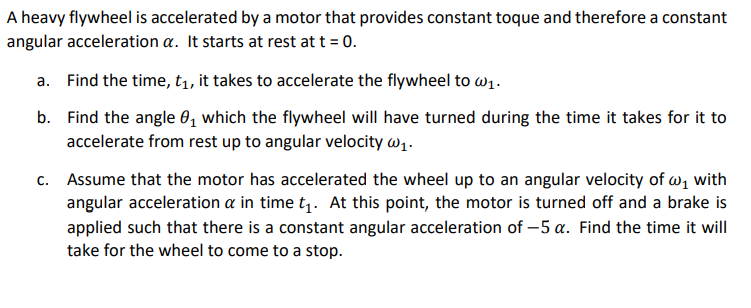A heavy flywheel is accelerated by a motor that provides constant toque and therefore a constant angular acceleration a. It starts at rest at t = 0. a. Find the time, t1, it takes to accelerate the flywheel to w1. b. Find the angle 0, which the flywheel will have turned during the time it takes for it to accelerate from rest up to angular velocity w1. c. Assume that the motor has accelerated the wheel up to an angular velocity of w, with angular acceleration a in time t . At this point, the motor is turned off and a brake is applied such that there is a constant angular acceleration of -5 a. Find the time it will take for the wheel to come to a stop.
A heavy flywheel is accelerated by a motor that provides constant toque and therefore a constant angular acceleration a. It starts at rest at t = 0. a. Find the time, t1, it takes to accelerate the flywheel to w1. b. Find the angle 0, which the flywheel will have turned during the time it takes for it to accelerate from rest up to angular velocity w1. c. Assume that the motor has accelerated the wheel up to an angular velocity of w, with angular acceleration a in time t . At this point, the motor is turned off and a brake is applied such that there is a constant angular acceleration of -5 a. Find the time it will take for the wheel to come to a stop.
University Physics Volume 1
18th Edition
ISBN:9781938168277
Author:William Moebs, Samuel J. Ling, Jeff Sanny
Publisher:William Moebs, Samuel J. Ling, Jeff Sanny
Chapter10: Fixed-axis Rotation
Section: Chapter Questions
Problem 11CQ: Suppose a piece of food is on the edge of a rotating microwave oven plate. Does it experience...
Related questions
Question

Transcribed Image Text:A heavy flywheel is accelerated by a motor that provides constant toque and therefore a constant
angular acceleration a. It starts at rest at t = 0.
a. Find the time, t1, it takes to accelerate the flywheel to w1.
b. Find the angle 0, which the flywheel will have turned during the time it takes for it to
accelerate from rest up to angular velocity w1.
c. Assume that the motor has accelerated the wheel up to an angular velocity of w, with
angular acceleration a in time t . At this point, the motor is turned off and a brake is
applied such that there is a constant angular acceleration of -5 a. Find the time it will
take for the wheel to come to a stop.
Expert Solution
This question has been solved!
Explore an expertly crafted, step-by-step solution for a thorough understanding of key concepts.
This is a popular solution!
Trending now
This is a popular solution!
Step by step
Solved in 2 steps with 2 images

Knowledge Booster
Learn more about
Need a deep-dive on the concept behind this application? Look no further. Learn more about this topic, physics and related others by exploring similar questions and additional content below.Recommended textbooks for you

University Physics Volume 1
Physics
ISBN:
9781938168277
Author:
William Moebs, Samuel J. Ling, Jeff Sanny
Publisher:
OpenStax - Rice University

Glencoe Physics: Principles and Problems, Student…
Physics
ISBN:
9780078807213
Author:
Paul W. Zitzewitz
Publisher:
Glencoe/McGraw-Hill

College Physics
Physics
ISBN:
9781938168000
Author:
Paul Peter Urone, Roger Hinrichs
Publisher:
OpenStax College

University Physics Volume 1
Physics
ISBN:
9781938168277
Author:
William Moebs, Samuel J. Ling, Jeff Sanny
Publisher:
OpenStax - Rice University

Glencoe Physics: Principles and Problems, Student…
Physics
ISBN:
9780078807213
Author:
Paul W. Zitzewitz
Publisher:
Glencoe/McGraw-Hill

College Physics
Physics
ISBN:
9781938168000
Author:
Paul Peter Urone, Roger Hinrichs
Publisher:
OpenStax College